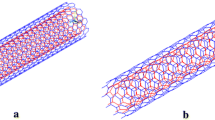Abstract
The main aim of this research was to investigate longitudinal elastic and effective modulus of composites reinforced with zigzag and armchair single-walled (CNT) and multi-walled carbon nanotubes (MWCNT) with different volume fractions and aspect ratios via finite element simulation. A three-phased volume element was adopted for the modeling of nanocomposite behavior and nonlinear spring elements were used to model interphase part joints and the effective force between nanotubes and resin were determined based on Lennard-Jones potential. After the evaluation and validation of the model, elastic modulus and Poisson’s ratio of composites reinforced with zigzag and armchair CNTs with different volume fractions and aspect ratios were extracted. It was found that by increasing volume fraction and aspect ratio, elastic modulus of representative volume element of composite was increased and its Poisson’s ratio was decreased. At similar aspect ratio and volume fraction, the elastic modulus of composites reinforced with armchair CNTs and Poisson’s ratio of those reinforced with zigzag CNTs were higher. Also, results showed that elastic modulus of composite was independent from elastic modulus of interphase.




















Similar content being viewed by others
Change history
08 February 2021
A Correction to this paper has been published: https://doi.org/10.1007/s00366-021-01324-8
References
Ci L, Bai J (2006) The reinforcement role of carbon nanotubes in epoxy composites with different matrix stiffness. Compos Sci Technol 66:599–603
Selmi A, Friebel C, Doghri I, Hassis H (2007) Prediction of the elastic properties of single walled carbon nanotube reinforced polymers: a comparative study of several micromechanical models. Compos Sci Technol 67:2071–2084
Lu Q, Bhattacharya B (2005) The role of atomistic simulations in probing the small-scale aspects of fracture—a case study on a single-walled carbon nanotube. Eng Fract Mech 72:2037–2071
Fattahi AM, Najipour A (2017) Experimental study on mechanical properties of PE/CNT composites. J Theor Appl Mech 55:719–726
Yu MF, Lourie O, Dyer MJ, Moloni K, Kelly TS, Ruoff RS (2000) Strength and breaking mechanism of multiwalled carbon nanotubes under tensile load. Science 287:637–640
Tombler TW, Zhou C, Alexeyev L (2000) Reversible electromechanical characteristics of carbon nanotubes under local-probe manipulation. Nature 405:769–772
Azizi S, Fattahi AM, Kahnamouei JT (2015) Evaluating mechanical properties of nanoplatelet reinforced composites under mechanical and thermal loads. Comput Theor Nanosci 12:4179–4185
Lu JP (1997) Elastic properties of carbon nanotubes and nanoropes. Phys Rev Lett 79:1297–1300
Hernandez E, Goze C, Bernier P, Rubio A (1999) Elastic properties of single-wall nanotubes. Appl Phys A 68:287–292
Prylutskyy YuI, Durov SS, Ogloblya OV, Buzaneva EV, Scharff P (2000) Molecular dynamics simulation of mechanical, vibrational and electronic properties of carbon nanotubes. Comput Mater Sci 17:352–355
Sinnott SB (2002) Chemical functionalization of carbon nanotubes. J Nanosci Nanotechnol 2:113–123
Bahr LL, Tour JM (2002) Covalent chemistry of single-wall carbon nanotubes. J Mater Chem 12:1952–1958
Frankland SJV, Caglar A, Brenner DW, Griebel M (2002) Molecular simulation of the influence of chemical cross-links on the shear strength of carbon nanotube polymer interfaces. J Phys Chem B 106:3046–3048
Buffa F, Abraham GA, Grady BP, Resasco D (2007) Effect of nanotube functionalization on the properties of single-walled carbon nanotube/polyurethane composites. J Polym Sci Part B Polym Phys 45:490–501
Shokrieh MM, Rafiee R (2010) Stochastic multi-scale modeling of CNT/polymer composites. Comput Mater Sci 50:437–446
Spanos PD, Kontsos A (2008) A multiscale Monte Carlo finite element method for determining mechanical properties of polymer nanocomposites. Probab Eng Mech 23:456–470
Safaei B, Moradi-Dastjerdi R, Chu F (2018) Effect of thermal gradient load on thermo-elastic vibrational behavior of sandwich plates reinforced by carbon nanotube agglomerations. Compos Struct 192:28–37
Safaei B, Moradi-Dastjerdi R, Qin Z, Chu F (2019) Frequency-dependent forced vibration analysis of nanocomposite sandwich plate under thermo-mechanical loads. Compos B Eng 161:44–54
Safaei B, Moradi-Dastjerdi R, Qin Z, Behdinan K, Chu F (2019) Determination of thermoelastic stress wave propagation in nanocomposite sandwich plates reinforced by clusters of carbon nanotubes. J Sandw Struct Mater. https://doi.org/10.1177/1099636219848282
Safaei B, Moradi-Dastjerdi R, Behdinan K, Qin Z, Chu F (2019) Thermoelastic behavior of sandwich plates with porous polymeric core and CNT clusters/polymer nanocomposite layers. Compos Struct 226:111209
Qin Z, Chu F, Jean Z (2017) Free vibrations of cylindrical shells with arbitrary boundary conditions: a comparison study. Int J Mech Sci 133:91–99
Qin Z, Yang Z, Zu J, Chu F (2018) Free vibration analysis of rotating cylindrical shells coupled with moderately thick annular plates. Int J Mech Sci 142–143:127–139
Qin Z, Pang X, Safaei B, Chu F (2019) Free vibration analysis of rotating functionally graded CNT reinforced composite cylindrical shells with arbitrary boundary conditions. Compos Struct 220:847–860
Safaei B, Naseradinmousavi P, Rahmani A (2016) Development of an accurate molecular mechanics model for buckling behavior of multi-walled carbon nanotubes under axial compression. J Mol Graph Model 65:43–60
Fattahi AM, Safaei B (2017) Buckling analysis of CNT-reinforced beams with arbitrary boundary conditions. Microsyst Technol 23(10):5079–5091
Safaei B, Fattahi AM (2019) Free vibration analysis of polyethylene/CNT plates. Eur Phys J Plus 134(6):271
Safaei B, Fattahi AM, Chu F (2018) Finite element study on elastic transition in platelet reinforced composites. Microsyst Technol 24:2663–2671
Roozpeikar S, Fattahi AM (2018) Evaluation of elastic modulus in PE/CNT composites subjected to axial loads. SN Appl Sci 1(1):17
Jalali MH, Zargar O, Baghani M (2019) Size-dependent vibration analysis of FG microbeams in thermal environment based on modified couple stress theory. Iran J Sci Technol Trans Mech Eng 43:761–771
Jalali MH, Shahriari B, Zargar O, Baghani M, Baniassadi M (2018) Free vibration analysis of rotating functionally graded annular disc of variable thickness using generalized differential quadrature method. Sci Iran 25:728–740
Mohammadsalehi M, Zargar O, Baghani M (2017) Study of non-uniform viscoelastic nanoplates vibration based on nonlocal first-order shear deformation theory. Meccanica 52:1063–1077
Fattahi AM, Safaei B, Moaddab E (2019) The application of nonlocal elasticity to determine vibrational behavior of FG nanoplates. Steel Compos Struct 32:281–292
Safaei B, Khoda FH, Fattahi AM (2019) Non-classical plate model for single-layered graphene sheet for axial buckling. Adv Nano Res 7:265–275
Fattahi AM, Safaei B, Ahmed NA (2019) A comparison for the non-classical plate model based on axial buckling of single-layered graphene sheets. Eur Phys J Plus 134:555
Azizi S, Safaei B, Fattahi AM, Tekere M (2015) Nonlinear vibrational analysis of nanobeams embedded in an elastic medium including surface stress effects. Adv Mater Sci Eng. https://doi.org/10.1155/2015/318539
Safaei B, Ahmed NA, Fattahi AM (2019) Free vibration analysis of polyethylene/CNT plates. Eur Phys J Plus 134:271
Safaei B, Moradi-Dastjerdi R, Behdinan K, Chu F (2019) Critical buckling temperature and force in porous sandwich plates with CNT-reinforced nanocomposite layers. Aerosp Sci Technol 91:175–185
Sahmani S, Fattahi AM (2017) An anisotropic calibrated non-local plate model for biaxial instability analysis of 3D metallic carbon nanosheets using molecular dynamics simulations. Mater Res Express 4(6):1–14
Sahmani S, Fattahi AM (2017) Calibration of developed non-local anisotropic shear deformable plate model for uniaxial instability of 3D metallic carbon nanosheets using MD simulations. Comput Methods Appl Mech Eng 322:187–207
Safaei B, Fattahi AM (2017) Free vibrational response of single-layered graphene sheets embedded in an elastic matrix using different non-local plate models. Mechanics 23(5):678–687
Alizadeh M, Fattahi AM (2019) Non-classical plate model for FGMs. Eng Comput 35(1):215–228
Sahmani S, Fattahi AM (2017) Development an efficient calibrated non-local plate model for nonlinear axial instability of zirconia nanosheets using molecular dynamics simulation. J Mol Graph Model 75:20–31
Moradi-Dastjerdi R, Behdinan K (2020) Stability analysis of multifunctional smart sandwich plates with graphene nanocomposite and porous layers. Int J Mech Sci 167:105283
Fattahi AM, Sahmani S (2017) Non-local temperature-dependent postbuckling behavior of FG-CNT reinforced nanoshells under hydrostatic pressure combined with heat conduction. Microsyst Technol 23(10):5121–5137
Fattahi AM, Sahmani S (2017) Size dependency in the axial postbuckling behavior of nanopanels made of functionally graded material considering surface elastic. Arab J Sci Eng 42:4617–4633
Rappe AK, Casewit CJ, Colwell KS, Goddard WA, Skiff WM (1992) A full periodic-table force field for molecular mechanics and molecular dynamics simulations. J Am Chem Soc 114:10024–10035
Belin T, Epron F (2005) Characterization methods of carbon nanotubes: a review. Mater Sci Eng 119:105–118
Rafiee R, Pouraziz R (2013) The effect of defects on the mechanical properties. Modares Mech Eng 13:165–175 (in Persian)
Kumar P, Srinivas J (2017) Elastic behavior of CNT-reinforced polymer composites with discontinuities in CNT configurations. In: IOP conference series: materials science
Shokrieh MM, Rafiee R (2010) Investigation of nanotube length effect on the reinforcement efficiency in carbon nanotube based composites. Compos Sci 92:2415–2420
Lordi V, Yao N (2011) Molecular mechanics of binding in carbon-nanotube-polymer composites. J Mater Res 15:2770–2779
Wernik JM, Meguid SA (2010) Multiscale modeling of the nonlinear response of nano-reinforced polymers. Acta Mech 217:1–16
Fiedler B, Gojny FH, Wichmann MHG, Nolte MCM, Schulte K (2006) Fundamental aspects of nano-reinforced composites. Compos Sci Technol 66:3115–3125
Hu Y, Shenderova OA, Hu Z, Padgett CW, Brenner DW (2006) Carbon nanostructures for advanced composites. Rep Prog Phys 69:1847–1895
Liu WK, Karpov EG, Park HS (2006) Nano mechanics and materials: theory, multiscale methods and application. Nano mechanics and materials, vol 334. Wiley, Hoboken
Banerjee D, Nguyen T, Chuang T (2016) Mechanical properties of single-walled carbon nanotube reinforced polymer composites with varied interphase’s modulus and thickness: a finite element analysis study. Comput Mater Sci 114:209–218
Gibson RF (2011) Principles of composite material mechanics, 2nd edn. CRC Press, Boca Raton, p 68
Author information
Authors and Affiliations
Corresponding author
Additional information
Publisher's Note
Springer Nature remains neutral with regard to jurisdictional claims in published maps and institutional affiliations.
Rights and permissions
About this article
Cite this article
Alemi Parvin, S., Ahmed, N.A. & Fattahi, A.M. Numerical prediction of elastic properties for carbon nanotubes reinforced composites using a multi-scale method. Engineering with Computers 37, 1961–1972 (2021). https://doi.org/10.1007/s00366-019-00925-8
Received:
Accepted:
Published:
Issue Date:
DOI: https://doi.org/10.1007/s00366-019-00925-8




